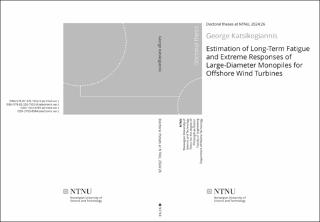| dc.description.abstract | Offshore wind energy is a crucial part of the global effort to transition towards a decarbonized energy system. In this context, the foundations used to support offshore wind turbines (OWTs) play a significant role in determining the feasibility of offshore wind projects, as they represent a substantial portion of the total capital expenditure. Currently, the most widely used type of foundation for OWTs is the monopile, due to its simple fabrication process, extensive installation experience, and proven reliability. However, as the offshore wind sector develops, employing larger turbines in size and capacity in deeper water depths, larger monopiles are required to withstand the increased loads, imposing challenges that need to be addressed.
The design of foundations for OWTs requires incorporating several engineering disciplines, considering various environmental and operational conditions, load scenarios, and design criteria to ensure the structural integrity of the foundation its operational lifetime. The behaviour of large-diameter monopiles differs notably from the smaller ones used in earlier offshore wind developments or the long, slender piles commonly used in i.e. the oil & gas industry. The thesis aims to further develop computationally efficient design methods and evaluate the impact of state-of-the-art physical load models compared to widely used approaches for long-term responses, ensuring that monopiles remain a reliable and cost-effective option in offshore wind energy.
OWTs are complex systems with nonlinearities and strong coupling between environmental loads and structural responses. Full long-term fatigue assessment (FLTA) using time-domain simulations is the most accurate approach, but requires extensive computational effort due to the large number of load cases involved. To reduce the computational burden, environmental lumping can be employed to select a representative set of sea states for fatigue design. The thesis introduces an environmental lumping method which considers the wind-wave environment and the dynamics of the OWT to ensure fatigue damage prediction along the support structure with accuracy above 90%, while reducing computational effort more than 95% compared to FLTA. The method is extended to consistently account for wind-sea and swell components, with similar levels of accuracy and effort.
The design of OWTs should also ensure their integrity under extreme conditions. The full long-term analysis that considers all sea states and response variability is commonly proposed, but it is computationally intensive. The environmental contour method (ECM) is a widely used alternative, approximating extreme responses by analyzing short-term conditions along the contour. However, directly applying the ECM to OWTs poses challenges due to non-monotonic wind loads, which become more critical for larger turbines and, when combined with waves near the OWT’s natural period, can cause extreme responses even in non-extreme wind speeds. Furthermore, neglecting metocean variables important for responses in the establishment of contours may affect the estimated extremes. The uncertainty associated with extreme responses using the ECM at representative wind speeds is investigated, highlighting their sensitivity to the probabilistic models used for the wave parameters and the stochastic variation due to seed variability.
Additionally to the methods applied for design purposes, numerical models used for global analysis are essential for the estimated dynamic behaviour and responses. Specifically, the widely used p − y approach for modelling pile behaviour in OWTs reveals several limitations when applied to largediameter monopiles, arising from omitting critical aspects of soil behaviour, differences in loading conditions (e.g., dominant bending moments), and their relatively rigid behaviour, which contrast with the p − y assumptions. Fatigue and extreme responses using p−y curves are compared to an elastoplastic model, which captures the non-linear load-displacement response, hysteretic damping, and soil resistance components, depicting the importance of soil damping, particularly when aerodynamic damping is negligible.
Finally, current engineering models cannot account for diffraction effects when higher-order wave kinematic theories are used, as MacCamy and Fuchs’s approach only applies to linear waves. As diffraction becomes increasingly important for larger diameters, a new load model was developed, which combines the conventional Morison’s formulation with a frequency-dependent mass coefficient from MacCamy and Fuchs theory. The conventional Morison’s load model is compared to the new load model using 2nd-order wave kinematics for extreme loads and responses. | en_US |
